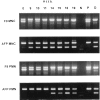T cells recognizing leukemic CD34(+) progenitor cells mediate the antileukemic effect of donor lymphocyte infusions for relapsed chronic myeloid leukemia after allogeneic stem cell transplantation
- PMID: 9707616
- PMCID: PMC21477
- DOI: 10.1073/pnas.95.17.10152
T cells recognizing leukemic CD34(+) progenitor cells mediate the antileukemic effect of donor lymphocyte infusions for relapsed chronic myeloid leukemia after allogeneic stem cell transplantation
Abstract
Adoptive immunotherapy with donor lymphocyte infusions (DLI) is an effective treatment for relapsed chronic myeloid leukemia (CML) after allogeneic stem cell transplantation. To identify the effector and target cell populations responsible for the elimination of the leukemic cells in vivo we developed an assay to measure the frequency of T lymphocyte precursor cells capable of suppressing leukemic progenitor cells. Target cells in this assay were CML cells that were cultured in the presence of stem cell factor, interleukin 3, granulocyte-macrophage colony-stimulating factor, granulocyte colony-stimulating factor, and erythropoietin. [3H]thymidine incorporation at day 7 represented the proliferation of the progeny of the CD34(+) CML progenitor cells, and not of the more mature CD34(-) CML cells. Effector cells were mononuclear cells, which were used in a limiting dilution analysis to measure the frequencies of CML progenitor cell-inhibitory lymphocyte precursors (PCILp) in peripheral blood of seven patients before and after DLI for relapsed CML. In the six patients who entered complete remission, a 5- to 100-fold increase of PCILp was found during the clinical response. In the patient with resistant relapse the frequency of PCILp was <10 per ml before and after DLI. Leukemia-reactive helper T lymphocyte precursor frequencies remained unchanged after DLI. A significant increase in cytotoxic T lymphocyte precursor frequency against more mature leukemic cells was found in only two responding patients. These results indicate that T cells specifically directed against CD34(+) CML progenitor cells mediate the antileukemic effect of DLI.
Figures





Similar articles
-
The progenitor cell inhibition assay to measure the anti-leukemic reactivity of T cell clones against acute and chronic myeloid leukemia.Methods. 2003 Oct;31(2):113-9. doi: 10.1016/s1046-2023(03)00120-8. Methods. 2003. PMID: 12957568
-
Complete remission of accelerated phase chronic myeloid leukemia by treatment with leukemia-reactive cytotoxic T lymphocytes.Blood. 1999 Aug 15;94(4):1201-8. Blood. 1999. PMID: 10438707
-
Molecular persistence of chronic myeloid leukemia caused by donor T cells specific for lineage-restricted maturation antigens not recognizing immature progenitor-cells.Leukemia. 2006 Jun;20(6):1040-6. doi: 10.1038/sj.leu.2404169. Leukemia. 2006. PMID: 16525495
-
Donor lymphocyte infusions for relapse of chronic myeloid leukemia after allogeneic stem cell transplant: where we now stand.Exp Hematol. 1999 Oct;27(10):1477-86. doi: 10.1016/s0301-472x(99)00096-x. Exp Hematol. 1999. PMID: 10517488 Review.
-
Donor lymphocyte infusions for patients who relapse after allogeneic stem cell transplantation for chronic myeloid leukaemia.Leuk Lymphoma. 2003 Jan;44(1):23-8. doi: 10.1080/1042819021000050061. Leuk Lymphoma. 2003. PMID: 12691139 Review.
Cited by
-
Antigen Discovery and Therapeutic Targeting in Hematologic Malignancies.Cancer J. 2017 Mar/Apr;23(2):115-124. doi: 10.1097/PPO.0000000000000257. Cancer J. 2017. PMID: 28410299 Free PMC article. Review.
-
High PR3 or ELA2 expression by CD34+ cells in advanced-phase chronic myeloid leukemia is associated with improved outcome following allogeneic stem cell transplantation and may improve PR1 peptide-driven graft-versus-leukemia effects.Blood. 2007 Jul 15;110(2):770-5. doi: 10.1182/blood-2007-02-071738. Epub 2007 Apr 5. Blood. 2007. PMID: 17412886 Free PMC article.
-
Leukemia vaccines.Curr Oncol Rep. 2001 May;3(3):193-200. doi: 10.1007/s11912-001-0050-3. Curr Oncol Rep. 2001. PMID: 11296128 Review.
-
The abl/bcr gene product as a novel leukemia-specific antigen: peptides spanning the fusion region of abl/bcr can be recognized by both CD4+ and CD8+ T lymphocytes.Cancer Immunol Immunother. 2003 Feb;52(2):89-96. doi: 10.1007/s00262-002-0362-7. Epub 2003 Jan 21. Cancer Immunol Immunother. 2003. PMID: 12594572 Free PMC article.
-
Hematopoiesis-restricted minor histocompatibility antigens HA-1- or HA-2-specific T cells can induce complete remissions of relapsed leukemia.Proc Natl Acad Sci U S A. 2003 Mar 4;100(5):2742-7. doi: 10.1073/pnas.0530192100. Epub 2003 Feb 24. Proc Natl Acad Sci U S A. 2003. PMID: 12601144 Free PMC article.
References
-
- Falkenburg J H F, Smit W M, Willemze R. Immunol Rev. 1997;157:223–230. - PubMed
-
- Weiden P L, Flournoy N, Thomas E D, Prentice R, Fefer A, Buckner C D, Storb R. N Engl J Med. 1979;300:1068–1073. - PubMed
-
- Gale R P, Horowitz M M, Ash R C, Champlin R E, Goldman J M, Rimm A A, Ringden O, Stone J A V, Bortin M M. Ann Intern Med. 1994;120:646–652. - PubMed
-
- Apperley J F, Jones L, Hale G, Waldmann H, Hows J, Rombos Y, Tsatalas C, Marcus R E, Goolden A W, Gordon Smith E C, et al. Bone Marrow Transplant. 1986;1:53–66. - PubMed
-
- Goldman J M, Gale R P, Horowitz M M, Bigs J C, Champlin R E, Gluckman E, Hoffmann R G, Jacobsen S J, Marmont A M, McGlave P B, et al. Ann Int Med. 1988;108:806–814. - PubMed
Publication types
MeSH terms
Substances
LinkOut - more resources
Full Text Sources
Other Literature Sources
Medical

